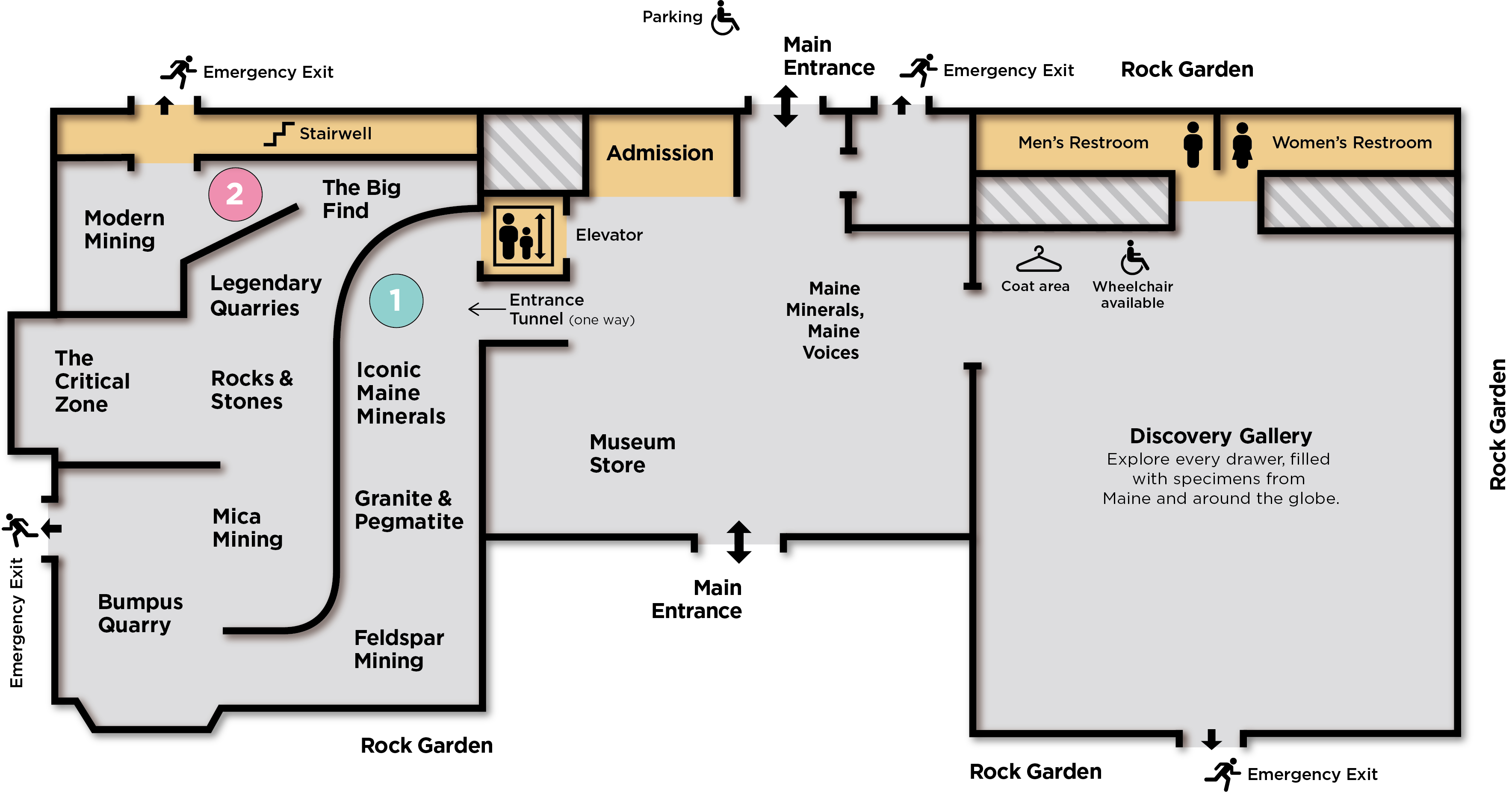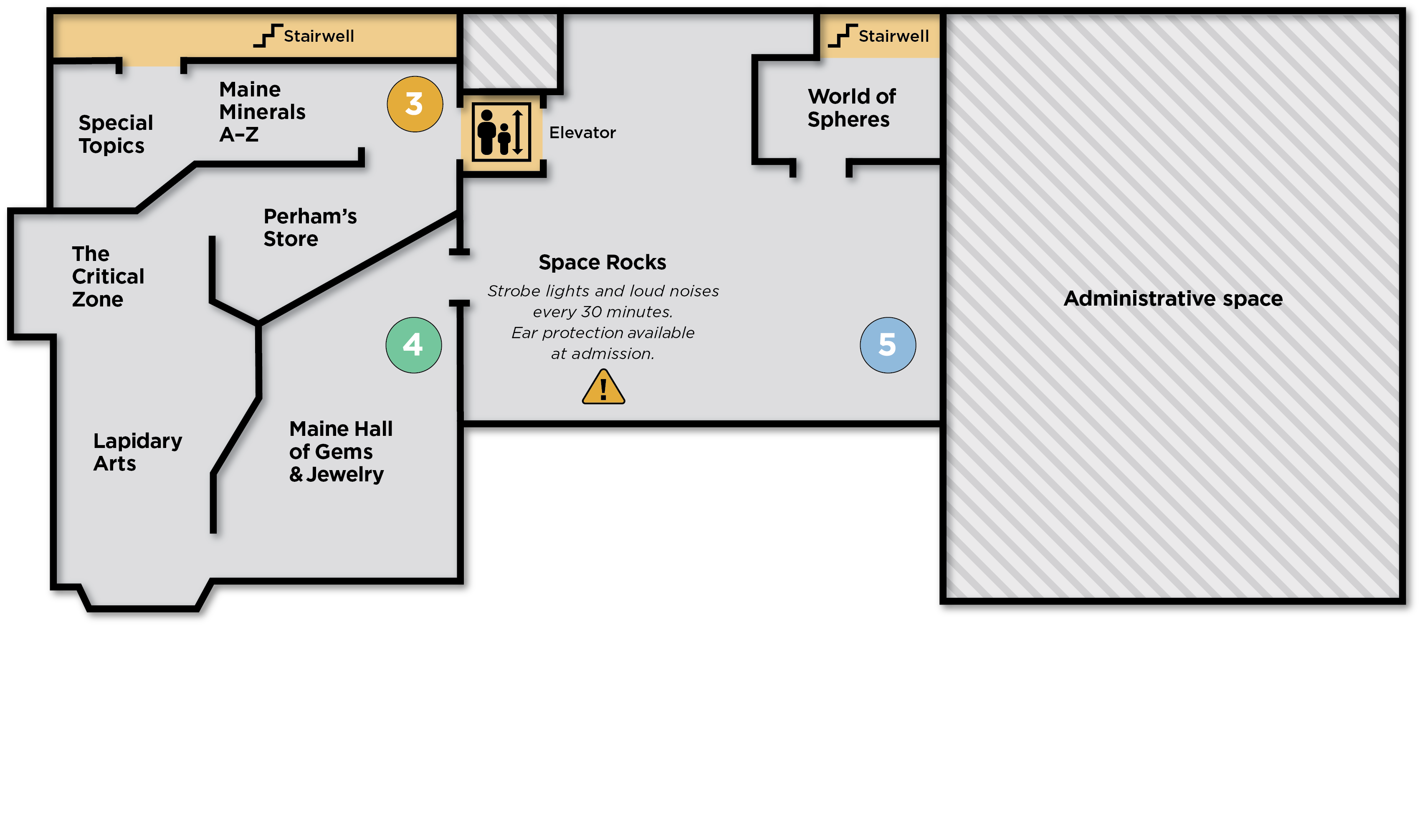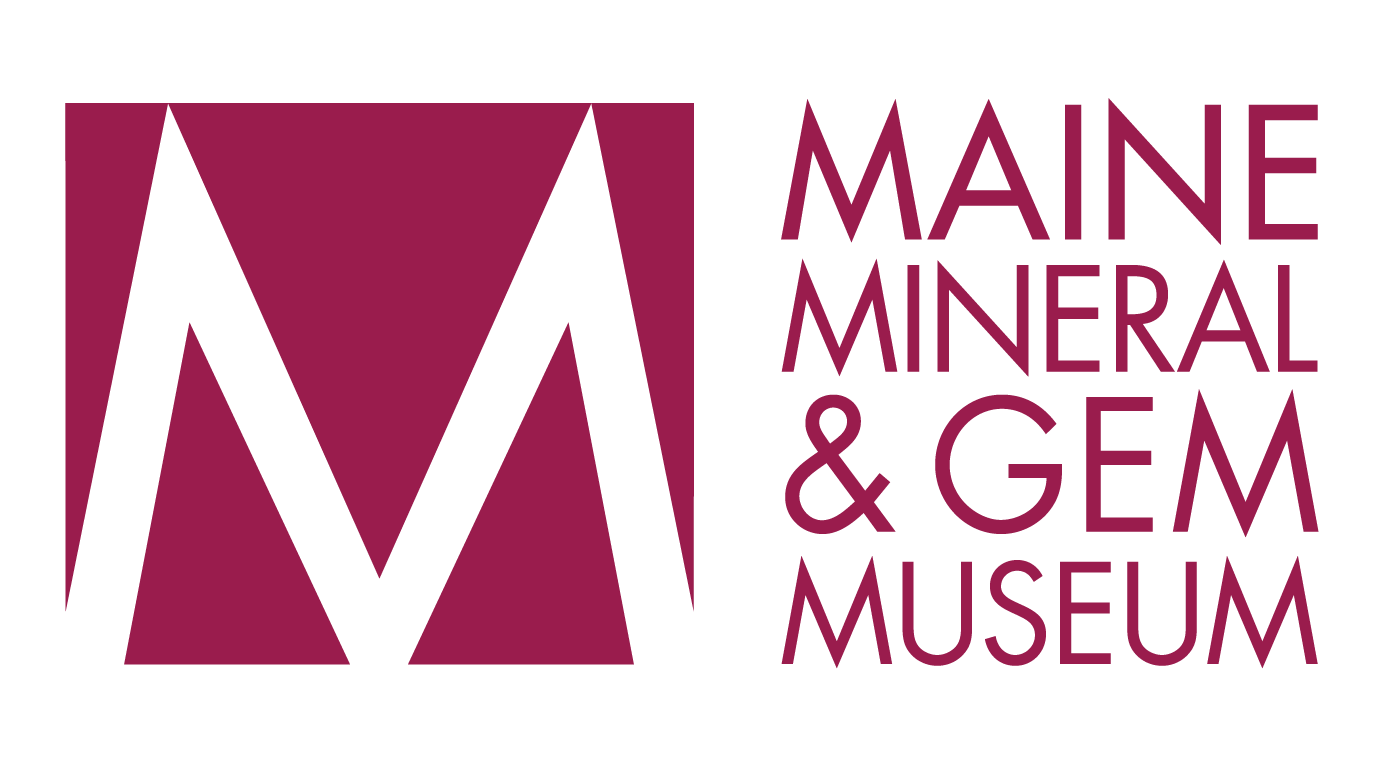Museum Map
View/download our maps of the museum exhibits on the upper level and lower level at MMGM before your visit, or pick up a copy at the admissions desk. We’re happy to answer any questions to help you have a great visit.
Lower Level

A curved wall leads visitors through this exhibit where they are introduced to outstanding specimens of Maine’s most important gem minerals along with exceptional gemstones cut by some of the area’s finest lapidary artists.
An interactive map of the state shows the locations from which of all the rocks, minerals and gems in the museum’s displays originated. Granite, which was extensively quarried in Maine, is featured in this exhibit. Touchable specimens and a set of unique baseball-sized polished spheres illustrate the broad range of color and texture found in Maine granites. A large polished slab of pegmatite from the Havey quarry is also on display. Pegmatite, a coarse-grained rock in the granite family, was quarried locally for feldspar, mica and ultimately for the tourmaline, amethyst and other gemstones for which the region is known.
A large hand-drawn map by Stanley Perham and vintage photos by renowned area artist Vivian Akers shed light on the process of mining and milling feldspar in West Paris. An original mining model from the Perham’s Mineral Shop and a one-ton feldspar crystal are accompanied by an historic ore cart and a special display where visitors experience a simulated dynamite blast. Encountered here are the first of many video screens that “people” the exhibits with “curated stories” illuminating some of the colorful characters involved in the mining of Maine’s minerals and gems.
Rich historical photographs and a detailed geological map bring to life the nearby Bumpus quarry, a significant supplier of feldspar to the West Paris mill and the source of the famous giant beryl crystal displayed outside the museum. A suite of the mineral species found at the quarry are prominently displayed. Not commercially active these days, the quarry has seen thousands of area students for educational tours over the last decade.
Historic film footage from the Wheeler Brothers mica shop on Main Street in Bethel conveys how mica books from local pegmatite quarries were “cut” to yield commercial mica sheets. Also featured is an eclectic collection of mica-related products including mica “snow” and antique housewares.
The economic impact of Maine’s mineral resources is explored here. “Rocks” (the scientific term) are explained by a rock cycle diagram including various specimens from around the state. “Stones” (the commercial term) are represented by the granite, slate, and marble resources that have been extensively utilized in architecture and industry.
A realistic two-story diorama displaying a cross-section at the earth’s surface is the Museum’s educational centerpiece. The below-ground portion on the first floor offers a deep dive into area geology. The second floor features local natural history. Interactive digital displays and augmented reality offer the curious viewer a rich, multi layered experience.
The storied history of the 1820 gem discovery and subsequent transition of Mt. Mica from feldspar mine to gem mine is illuminated through first-hand accounts, historic watercolor sketches by Augustus Hamlin and the display of important specimens. “Primus” the first tourmaline gemstone discovered in North America* is displayed in the Museum’s reception area. Also explored here are the quarries at Newry which produced the widest variety of mineral species and commercial minerals of all Maine’s pegmatites.
The Week Everything Changed – In 1972 amateur collectors made a bonanza discovery at the Dunton quarry in Newry, ultimately producing over a ton of gem quality tourmaline. Historic photographs and diary entries from the miners reflect the excitement of the event which launched the Plumbago Mining Corporation and stimulated others to search for and make new discoveries. Maps, artifacts from the mine, and important mineral and gem specimens from the location further engage the visitor’s imagination.
Local mines including Mt. Mica, Mt. Marie, Deer Hill, and the Havey and Bennett Quarries continue to engage the local mining community, producing impressive specimens and gem quality material. Choice examples of minerals and gemstones from each mine are accompanied by videos, photographs, maps of the sites, and biographies of the miners.
Upper Level

More than 100 of Maine’s many mineral species are on display in this interactive, alphabetically organized exhibit. Detailed electronic labels and 360-degree photography allow visitors to investigate the carefully curated specimens in great depth.
Local “rock” shops trading in minerals, gems, and jewelry are a small but colorful part the region’s economy. The legendary Perham’s in West Paris delighted locals and tourists for nearly a century before closing in 2009. The finest of the larger specimens from The Perham collection are showcased here. A diorama features a figure of Stan Perham in his shop, circa 1950, holding a notable amethyst crystal from Deer Hill in Stow. Interior and exterior photos of the shop, some of Perham’s jewelry and other artifacts are displayed within the store setting.
Frank C. Perham: Master Pegmatite Miner – Highlights from his extensive mineral collection are prominently featured in this gallery celebrating the life of Frank Perham, one of the most experienced and respected pegmatite miners working in western Maine.
Gem cutting and jewelry making have been a local cottage industry for more than a century. The art of tumbling, cabbing and faceting gems is explored through the display of historic faceting machines, models of different cuts, and a time elapsed video of a gem being cut.
Ten freestanding mirrored glass pylons showcase Maine’s finest gems—including amethyst, aquamarine and tourmaline. Digital labels featuring enlarged photographs of the gems will display important information about each specimen including the gem’s origin, miner, lapidary artist, and provenance. In addition, custom jewelry masterworks will be displayed, each meticulously designed and crafted with Maine gems by esteemed artists from around the country.The Maine Hall of Gems is a pinnacle exhibit and celebrates the journey of discovery from when minerals are mined to when artfully faceted stones are revealed.
Some are older than Earth itself, some originate from the Moon and Mars, others contain amino acids—the building blocks of life—and then there are those that contain extraterrestrial gems. Stunning examples of all of these varieties and more are on display at the MMGM.
A magnificent sculpture in the form of a globe featuring polished stone spheres from around the world. The exhibit celebrates a fascinating one-of-a-kind collection of over 800 rock specimens cut and polished by the distinguished lapidary artist and MMGM board member, Dr. R.F. Ritchie of Falmouth.
